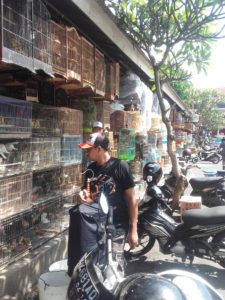
Songbirds in Southeast Asia have become the subject of an excessive but culturally deep-rooted consumption for trade, singing competitions, pets, status symbols, export, traditional medicine and food. Demand for songbirds in Southeast Asia is extremely high, affecting hundreds of species and involving millions of individual birds, annually. The trade is often illegal and evidently unsustainable; thus, it has been recognised as a primary threat for many species in Southeast Asia, particularly the Greater Sunda region. Comprising of Brunei, western Indonesia (Bali, Java, Kalimantan and Sumatra), Singapore, Malaysia, southern Myanmar and southern Thailand, the Greater Sundas are an ecologically diverse region, home to more than 850 bird species, and globally recognised as a biodiversity hotspot with high levels of endemism. Currently, Indonesia has one of the highest number of bird species assessed as threatened with global extinction in the world and the highest one in Asia (Critically Endangered, Endangered or Vulnerable; IUCN Red List, 2017).
Play the YouTube movie below to see a short introduction about the threats the songbirds face and why the campaign is essential to their survival.
And why here?

The problem is cultural. In Southeast Asia, caged songbirds have long been favourite family pets. Bird ownership is a celebrated custom and everyone can buy some kind of bird in the market, regardless of their social status. However, it is not simply about pets. Songbird competitions are also culturally important and provide financial motivation for family income. While the tradition may have evolved and altered over time, the culture of keeping songbirds has endured and turned into a sport and a massive industry that includes all sub-suppliers for cages, food, supplements. There is a myriad of bird clubs, while songbird competitions are major “sporting” events, making them a lucrative business. Although there are many legitimate captive breeders in Indonesia, there are still an alarming number of trappers, wholesalers and shops illegally trading in wild-caught birds. This is mainly because people believe that wild birds sing better and are stronger and more potent. Moreover, it is simply often much easier to catch rather than breed a songbird. Unfortunately, huge numbers of wild-caught birds do not live beyond the first few days in their cages.
And why now?
The degree of pressure on songbirds in Asia is devastating and has long been grossly underestimated. Our understanding of the status of wild populations is not developing as fast as particular bird species are disappearing, and IUCN categories are having to change much faster than usual to reflect the actual situation. Moreover, only a small number of the affected species are currently protected under national (range countries) and international regulations, and enforcement is regrettably deemed insufficient for many of the priority species, despite their being locally protected.

Between 2017 and 2019 Zoos of the European Association of Zoos and Aquaria (EAZA) joined forces in a conservation Campaign aiming to address and mitigate the ongoing songbird extinction crisis in Asia and increase awareness within and beyond the zoo community. Achieving these aims means ensuring the zoo community has the capability to scramble the resources needed in manpower, know-how and funding to save a growing number of Asian songbird species from imminent extinction.
The campaign focuses on following activities:
within the EAZA region:
- Increase awareness in the general public and within the zoo world.
- Fundraise for conservation efforts to prevent extinctions.
- Provide ideas and information to enable environmental education in zoos.
- Provide know-how, mentorship and manpower to support and initiate conservation breeding programs and related ex-situ research activities.
within the natural range:
- Increase regional awareness and implement environmental education strategies in cooperation with local and international stakeholders.
- Develop regionally relevant husbandry guidelines for all focus species, and support their legal scientifically managed breeding in-region.
- Build awareness and capacity for law enforcement within the region.
- Initiate, develop and support in-region conservation breeding centres where this is deemed necessary.
- Support research initiatives designed to improve the scientific basis of reintroduction programmes
The EAZA Silent Forest Campaign ran from 1 September 2017 to 31 December 2019. More than 200 zoos signed-up in support and more than €550.000 Euro were raised. The activities and projects initiated during this period will continue as the Silent Forest Group a working-group of the EAZA Songbird Taxon Advisory Group (Songbird TAG) and the fundraising and technical project support is now a permanent activity and commitment of the Songbird TAG.
Read more about EAZA Conservation Campaigns here or view the short video below.
